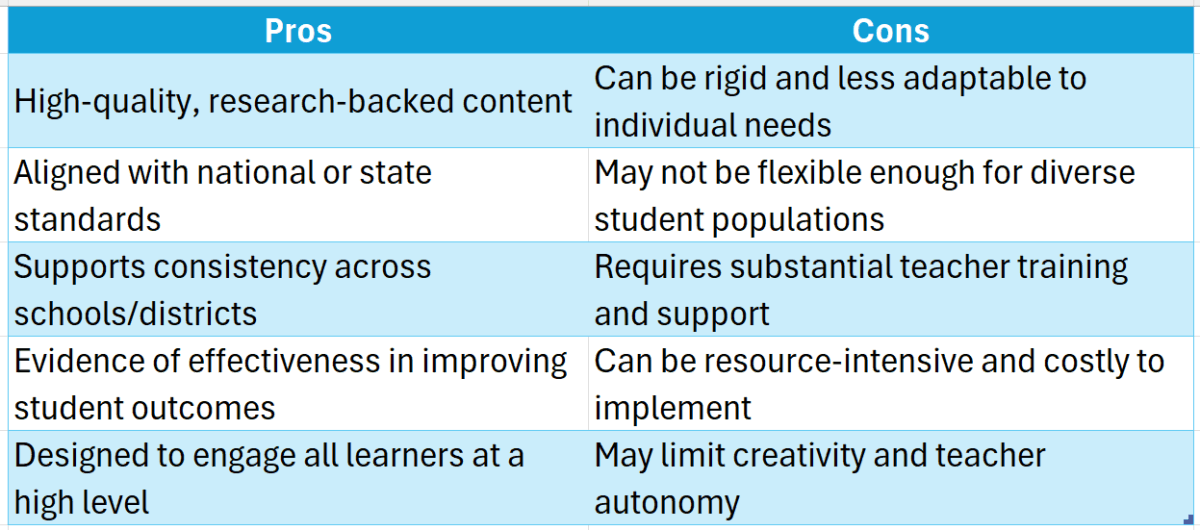
Understanding how a tier 1 curriculum supports school-wide learning goals is crucial for educators and students alike. This foundational curriculum sets the stage for effective teaching and learning, ensuring that all students receive high-quality instruction. When designed well, it aligns with the school’s objectives, helping everyone work towards common goals.
The Importance of Alignment
A well-structured tier 1 curriculum ensures that all students, regardless of their backgrounds, have access to the same learning opportunities. This alignment is essential for achieving school-wide goals, as it promotes consistency in teaching methods and assessment.
Key Benefits of Tier 1 Curriculum
- Inclusivity: It addresses diverse learning needs, making education accessible for everyone.
- Engagement: With engaging examples of instructional resources, students are more likely to participate actively in their learning.
- Foundation for Growth: It provides a solid base for more advanced learning in later tiers, ensuring students are prepared for future challenges.
In conclusion, a strong tier 1 curriculum is not just about content; it’s about creating a cohesive learning environment. For those interested in curriculum designer remote jobs, understanding this role is vital. By focusing on effective instructional resources, educators can foster a culture of success that resonates throughout the entire school.
Affordable, accredited education—Start now!
How Does Tier 1 Curriculum Align with School-Wide Learning Goals?

Understanding how a tier 1 curriculum supports school-wide learning goals is crucial for educators and students alike. This curriculum serves as the foundation for all learning, ensuring that every student receives high-quality instruction. When aligned with school-wide goals, it creates a cohesive educational experience that benefits everyone.
Clear Learning Objectives
A well-designed tier 1 curriculum includes clear learning objectives that match the school’s overall goals. This alignment helps teachers focus on what students need to learn, making it easier to track progress and adjust instruction as needed.
Engaging Instructional Resources
Using engaging examples of instructional resources, such as interactive activities and multimedia tools, can enhance student learning. These resources not only support the curriculum but also keep students motivated and excited about their education.
Consistent Assessment Practices
Tier 1 curriculum promotes consistent assessment practices across the school. This means that all students are evaluated using the same standards, which helps ensure fairness and clarity in measuring student success.
The Impact of Tier 1 Curriculum on Student Engagement
The impact of a tier 1 curriculum on student engagement is profound. When schools align their teaching strategies with school-wide learning goals, students become more involved in their education. This alignment ensures that every student, regardless of their learning style, can access quality instruction that meets their needs.
Why Tier 1 Curriculum Matters
A well-designed tier 1 curriculum serves as the foundation for effective teaching. It provides all students with the same high-quality learning experiences. This approach not only supports academic growth but also fosters a sense of community and belonging among students.
Key Benefits of Tier 1 Curriculum
- Inclusivity: Every student receives the same level of instruction.
- Engagement: Interactive and relevant content keeps students interested.
- Consistency: A unified approach helps teachers collaborate effectively.
By utilizing examples of instructional resources, educators can create engaging lessons that resonate with students. This not only enhances learning but also prepares students for future challenges, making tier 1 curriculum essential for achieving school-wide goals.
What Are the Key Components of an Effective Tier 1 Curriculum?
When it comes to achieving school-wide learning goals, a strong Tier 1 curriculum is essential. This foundational curriculum not only sets the stage for student success but also aligns with the overall objectives of the school. By focusing on high-quality instruction for all students, it ensures that everyone has access to the same learning opportunities.
Clear Learning Objectives
An effective Tier 1 curriculum starts with clear learning objectives. These objectives guide both teachers and students, ensuring everyone knows what is expected. This clarity helps in measuring progress and aligning with school-wide goals.
Engaging Instructional Resources
Using engaging instructional resources is crucial. Examples of instructional resources include interactive lessons, multimedia tools, and hands-on activities. These resources not only capture students’ interest but also cater to different learning styles, making lessons more effective.
Continuous Assessment and Feedback
Finally, continuous assessment and feedback are vital. Regular check-ins help teachers adjust their instruction based on student needs. This responsiveness ensures that the curriculum remains effective and aligned with the school’s learning goals.
Strategies for Implementing Tier 1 Curriculum Across All Grades
Understanding how a tier 1 curriculum supports school-wide learning goals is crucial for educators. This approach ensures that all students receive high-quality instruction, which is essential for their academic success. By implementing a tier 1 curriculum, schools can create a unified learning environment that benefits every student, regardless of their individual needs.
Consistent Instructional Practices
- Use examples of instructional resources that align with the tier 1 curriculum. This consistency helps students grasp concepts better.
- Train teachers to deliver lessons in a similar style, fostering a cohesive learning experience across grades.
Collaborative Planning
- Encourage teachers to collaborate in planning lessons. This teamwork can lead to innovative ideas and shared resources, making the curriculum more engaging for students.
- Consider curriculum designer remote jobs to bring in fresh perspectives and expertise from outside the school community.
By focusing on these strategies, schools can effectively implement a tier 1 curriculum that supports their learning goals. This not only enhances student engagement but also promotes a culture of continuous improvement among educators. When everyone is on the same page, students thrive!
Measuring Success: Assessing the Effectiveness of Tier 1 Curriculum
When we talk about school-wide learning goals, the tier 1 curriculum plays a crucial role. It’s like the foundation of a house; without it, everything else can crumble. A well-designed tier 1 curriculum ensures that all students receive high-quality instruction, which is essential for achieving those ambitious goals. But how do we measure its success?
Understanding the Impact of Tier 1 Curriculum
To assess the effectiveness of a tier 1 curriculum, we can look at several key factors. First, consider student engagement. Are students excited about learning? Next, evaluate academic performance. Are test scores improving? Finally, gather feedback from teachers and students alike. This feedback can provide valuable insights into what works and what needs adjustment.
Key Insights on Measuring Success
- Student Engagement: Are students actively participating in lessons?
- Academic Performance: Are grades and test scores on the rise?
- Feedback: What do teachers and students say about the curriculum?
By focusing on these areas, schools can ensure their tier 1 curriculum effectively supports their learning goals, paving the way for future success.
Affordable, accredited education—Start now!
How Tier 1 Curriculum Supports Diverse Learning Needs
Understanding how a tier 1 curriculum supports school-wide learning goals is crucial for educators and students alike. This approach ensures that all students receive high-quality instruction that meets their diverse learning needs. By focusing on a tier 1 curriculum, schools can create a solid foundation for academic success.
Key Benefits of a Tier 1 Curriculum
- Inclusivity: A tier 1 curriculum is designed to cater to various learning styles, ensuring that every student can engage with the material.
- Consistency: It provides a uniform framework that aligns with school-wide learning goals, making it easier for teachers to collaborate and share resources.
- Examples of Instructional Resources: Curriculum designers often utilize a range of instructional resources, such as interactive lessons and multimedia tools, to enhance learning experiences.
Supporting Diverse Learning Needs
A tier 1 curriculum not only addresses the needs of all students but also empowers teachers. For those exploring curriculum designer remote jobs, understanding how to create inclusive materials is essential. This approach fosters a collaborative environment where students can thrive, ultimately supporting the school’s mission to promote academic excellence.
Real-Life Examples: Schools Excelling with Tier 1 Curriculum
Understanding how a tier 1 curriculum supports school-wide learning goals is crucial for educators and administrators. This curriculum serves as a foundation for all students, ensuring access to high-quality instruction. When effectively implemented, it can enhance student outcomes and create a cohesive learning environment.
Success Stories
- Maplewood High School adopted a tier 1 curriculum focusing on critical thinking and collaboration, leading to increased student engagement and higher test scores.
- Riverdale Elementary used instructional resources aligned with their tier 1 curriculum, achieving a 20% improvement in literacy rates over two years.
These examples show that a well-designed tier 1 curriculum not only meets academic standards but also supports the school’s mission.
Key Benefits
- Inclusivity: Addresses diverse learning needs, helping all students thrive.
- Consistency: Provides a uniform teaching approach, easing transitions between grades.
- Engagement: Keeps students interested and motivated through effective instructional resources.
In summary, a strong tier 1 curriculum is essential for achieving school-wide learning goals, laying the groundwork for student success and fostering a positive educational atmosphere.
How Degreesonline.education Can Enhance Your Tier 1 Curriculum Implementation
Understanding how a tier 1 curriculum supports school-wide learning goals is essential for educators. This approach ensures that all students receive high-quality instruction that meets their diverse needs. When implemented effectively, it can lead to improved student outcomes and a more cohesive educational environment.
Tailored Resources for Every Classroom
At Degreesonline.education, we provide examples of instructional resources that align with your tier 1 curriculum. These resources are designed to engage students and support teachers in delivering effective lessons. By using our materials, educators can easily adapt their teaching strategies to meet school-wide goals.
Professional Development Opportunities
We also offer training for curriculum designers in remote jobs, helping them understand the nuances of tier 1 implementation. This professional development ensures that all staff are equipped with the skills necessary to support a unified learning experience. With the right tools and training, schools can foster an environment where every student thrives.
Affordable, accredited education—Start now!
FAQs
1. What is a Tier 1 Curriculum?
A Tier 1 Curriculum refers to high-quality, research-based instructional materials and teaching practices used for all students in the classroom. It’s designed to meet the needs of the majority of students, ensuring that they receive effective core instruction.
2. How is a Tier 1 Curriculum different from Tier 2 and Tier 3?
Tier 1 curriculum is general, whole-class instruction that benefits all students. In contrast, Tier 2 involves targeted interventions for students who need additional support, while Tier 3 is for students requiring intensive, individualized instruction.
3. Who benefits from Tier 1 curriculum?
All students in a general education setting benefit from a Tier 1 curriculum, as it provides foundational teaching that addresses the core standards and skills necessary for success.
4. What makes a curriculum Tier 1?
A Tier 1 curriculum is evidence-based, aligned with grade-level standards, and designed to be engaging and accessible for most students. It includes differentiated instructional strategies to meet diverse learning needs within the general classroom setting.
5. How do teachers implement a Tier 1 Curriculum?
Teachers use a variety of teaching strategies to deliver Tier 1 instruction, such as whole-class lessons, group activities, and assessments. Differentiation is key to meeting the varying needs of students within the class, ensuring all learners can access the content.
6. Can a Tier 1 Curriculum be used for students with disabilities?
Yes, a Tier 1 curriculum is designed to be inclusive and accessible, with accommodations and modifications provided as needed to ensure all students, including those with disabilities, can participate and learn effectively.




